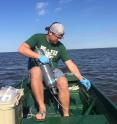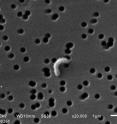Scientists craft an artificial seawater concoction
Microbiologists have concocted an artificial seawater medium that can be used to successfully cultivate abundant marine microorganisms, many of which have not been genetically characterized before. The recipe and study led by LSU doctoral candidate Michael Henson from Sylvania, Ohio and LSU Assistant Professor Cameron Thrash with support from LSU undergraduate researchers David Pitre from Houma, La., Celeste Lanclos from Opelousas, La. and Jessica Lee Weckhorst from Denham Springs, La. was published recently in the open access journal, mSphere. "Less than 1 percent of microbes have been cultivated, and we need new cultures," Henson said.
The research team developed a suite of four artificial sea water media that vary based on salinity to make it more accessible to more people to conduct this research.
"We developed an artificial media which means you can make it in the lab; and anyone can order these chemicals and make this media anywhere in the world," Thrash said.
The artificial seawater media consists of about 60 ingredients that include chemical elements such as calcium, sodium, magnesium plus organic and inorganic nitrogen, carbon, trace metals and B vitamins.
Prior to this discovery, many of the most abundant microorganisms in the ocean that have been successfully cultured were done so with the aid of natural seawater media. Seawater is naturally low in nutrients, and many marine microbes are adapted to those conditions. The painstaking culturing process that includes filtering and sterilizing the seawater can pose many challenges. First, it requires access to large volumes of seawater, which can be logistically challenging for research labs that are not located near the coast. Secondly, the composition of natural seawater is not clearly defined or understood; therefore, it is difficult to characterize it physiologically. Thirdly, the composition of seawater at various times and places chemically changes; it's not static.
"You get what we call 'vintages' of seawater at the same location over various periods of time," Thrash said. "Bacteria that grow easily in saltwater rarely grow easily in freshwater and vice versa."
To solve some of these challenges, his lab created a complex yet defined artificial seawater media that is portable and reproducible. Although there are other artificial seawater media available, this is the first time an artificial medium has led to the isolation of highly abundant marine microbes such as SAR11, a group of organisms that has been difficult to cultivate. This new tool may benefit genomics researchers, marine chemists and the microbial research community.
For this study, the scientists collected seawater from six sites along the southern Louisiana coast on the Gulf of Mexico that ranged in salinity from estuaries to marine environments. They diluted the microbial sample such that they could add a single cell per culture well filled with their new media via a technique called dilution-to-extinction. Then, they looked for an increase in cell growth over a few weeks, after which they extracted and sequenced DNA from the isolated microorganisms. The researchers verified the DNA of the microbes they collected in nature with the DNA of the microbes they grew in the lab. Numerous close relationships between the two groups of microorganisms shows an equal success rate for cultivation in the artificial seawater medium.
In addition to isolating highly abundant bacteria for the first time with artificial media, many of these microorganisms had never been cultured from the Gulf of Mexico before.
"We have first examples of versions of those organisms from here," Thrash said. "It's exciting."
These first cultivars are also critical to the research on how bacteria have adapted and evolved in the Gulf of Mexico compared to other parts of the world's oceans.
"We really don't know until we can cultivate these organisms if the ones in the Gulf of Mexico are the same as the ones on the Oregon coast or in the mid-Atlantic or in the Antarctic," Thrash said.
That's part of the Thrash Lab's larger research goal: to apply the Gulf of Mexico cultivars towards large-scale microbial biogeography and evolutionary studies. More than 200 strains of microorganisms from the Gulf of Mexico are part of the LSU Culture Collection. Many of these strains may be useful for other research. For example, some of these microbes may degrade hydrocarbons.
"The Gulf of Mexico is an incredibly dynamic system. The water is constantly changing in salinity. Based on those changes, you will see drastically different microbial communities. We had to develop media that reflect that dynamic," Henson said.
The researchers have made all of their data and supplemental materials publicly available online.
Source: Louisiana State University
Other sources
- Scientists Craft an Artificial Seawater Concoctionfrom Newswise - ScinewsWed, 8 Jun 2016, 14:20:56 UTC
- Scientists craft an artificial seawater concoctionfrom Science DailyTue, 7 Jun 2016, 19:21:13 UTC
- Scientists craft an artificial seawater concoctionfrom PhysorgTue, 7 Jun 2016, 17:00:56 UTC

